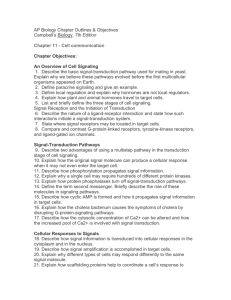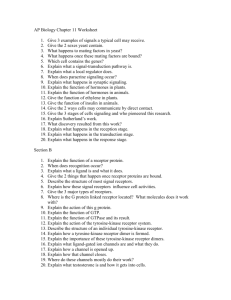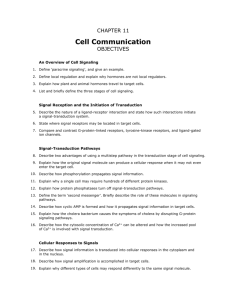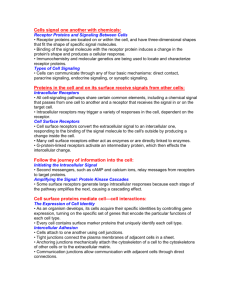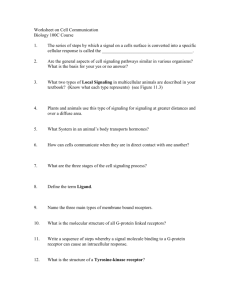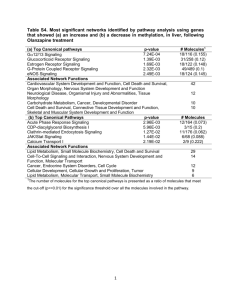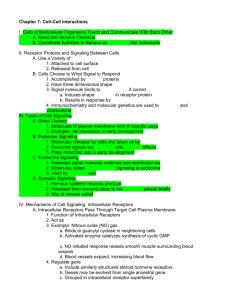CHAPTER 11 CELL COMMUNICATION
advertisement
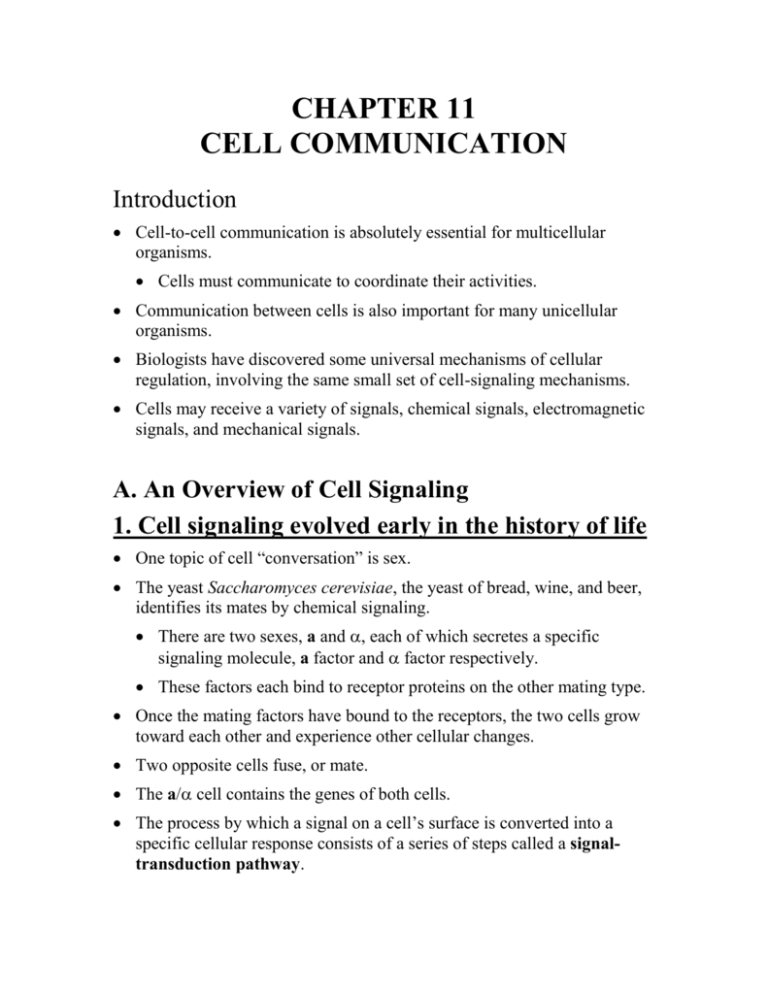
CHAPTER 11 CELL COMMUNICATION Introduction Cell-to-cell communication is absolutely essential for multicellular organisms. Cells must communicate to coordinate their activities. Communication between cells is also important for many unicellular organisms. Biologists have discovered some universal mechanisms of cellular regulation, involving the same small set of cell-signaling mechanisms. Cells may receive a variety of signals, chemical signals, electromagnetic signals, and mechanical signals. A. An Overview of Cell Signaling 1. Cell signaling evolved early in the history of life One topic of cell “conversation” is sex. The yeast Saccharomyces cerevisiae, the yeast of bread, wine, and beer, identifies its mates by chemical signaling. There are two sexes, a and , each of which secretes a specific signaling molecule, a factor and factor respectively. These factors each bind to receptor proteins on the other mating type. Once the mating factors have bound to the receptors, the two cells grow toward each other and experience other cellular changes. Two opposite cells fuse, or mate. The a/ cell contains the genes of both cells. The process by which a signal on a cell’s surface is converted into a specific cellular response consists of a series of steps called a signaltransduction pathway. The molecular details in both yeast and animal cells are strikingly similar, even though their last common ancestor was over a billion years ago. Signaling molecules evolved first in ancient prokaryotes and were then adopted for new uses by single-celled eukaryotes and multicellular descendents. Cell signaling has remained important in the microbial world. Myxobacteria, soil-dwelling bacteria, use chemical signals to communicate nutrient availability. When food is scarce, cells secrete a signal to other cells leading them to aggregate and form thick-walled spores. 2. Communicating cells may be close together or far apart Multicellular organisms also release signaling molecules that target other cells. Some transmitting cells release local regulators that influence cells in the local vicinity. Paracrine signaling occurs when numerous cells can simultaneously receive and respond to growth factors produced by a single cell in their vicinity. In synaptic signaling, a nerve cell produces a neurotransmitter that diffuses to a single cell that is almost touching the sender. An electrical signal passing along the nerve cell triggers secretion of the neurotransmitter into the synapse. Nerve signals can travel along a series of nerve cells without unwanted responses from other cells. Plants and animals use hormones to signal at greater distances. In animals, specialized endocrine cells release hormones into the circulatory system, by which they travel to target cells in other parts of the body. In plants, hormones may travel in vessels, but more often travel from cell to cell or by diffusion in air. Hormones and local regulators range widely in size and type. The plant hormone ethylene (C2H4), which promotes fruit ripening and regulates growth, is a hydrocarbon with only six atoms. Insulin, which regulates sugar levels in the blood of mammals, is a protein with thousands of atoms. Cells may communicate by direct contact. Signaling substances dissolved in the cytosol pass freely between adjacent cells. Cells may also communicate via direct contact between substances on their surfaces. 3. The three stages of cell signaling are reception, transduction, and response The origins of our understanding of cell signaling were pioneered by E.W. Sutherland and his colleagues. Their work investigated how the animal hormone epinephrine stimulates breakdown of the storage polysaccharide glycogen in liver and skeletal muscle. Breakdown of glycogen releases glucose derivatives that can be used for fuel in glycolysis or released as glucose in the blood for fuel elsewhere. One effect of the release of epinephrine from the adrenal gland is mobilization of fuel reserves. Sutherland’s research team discovered that epinephrine activated a cytosolic enzyme, glycogen phosphorylase. However, epinephrine did not activate the phosphorylase directly but could only act on intact cells. Therefore, there must be an intermediate step or steps occurring inside the cell. Also, the plasma membrane must be involved in transmitting the epinephrine signal. The process must involve three stages. In reception, a chemical signal binds to a cellular protein, typically at the cell’s surface. In transduction, binding leads to a change in the receptor that triggers a series of changes along a signal-transduction pathway. In response, the transduced signal triggers a specific cellular activity. B. Signal Reception and the Initiation of Transduction 1. A signal molecule binds to a receptor protein causing the protein to change shape A cell targeted by a particular chemical signal has a receptor protein that recognizes the signal molecule. Recognition occurs when the signal binds to a specific site on the receptor because it is complementary in shape. When ligands (small molecules that bind specifically to a larger molecule) attach to the receptor protein, the receptor typically undergoes a change in shape. This may activate the receptor so that it can interact with other molecules. For other receptors, this leads to the aggregation of receptors. 2. Most signal receptors are plasma membrane proteins Most signal molecules are water-soluble and too large to pass through the plasma membrane. They influence cell activities by binding to receptor proteins on the plasma membrane. Binding leads to change in the shape of the receptor or to the aggregation of receptors. These trigger changes in the intracellular environment. Three major types of receptors are G-protein-linked receptors, tyrosinekinase receptors, and ion-channel receptors. A G-protein-linked receptor consists of a receptor protein associated with a G protein on the cytoplasmic side. The receptor consists of seven alpha helices spanning the membrane. Effective signal molecules include yeast mating factors, epinephrine, other hormones, and neurotransmitters. The G protein acts as an on-off switch. If GDP is bound, the G protein is inactive. If ATP is bound, the G protein is active. The G protein system cycles between on and off. When a G-protein-linked receptor is activated by binding with an extracellular signal molecule, the receptor binds to an inactive G protein in membrane. This leads the G protein to substitute GTP for GDP. The G protein then binds with another membrane protein, often an enzyme, altering its activity and leading to a cellular response. The G protein can also act as a GTPase enzyme and hydrolyzes the GTP, which activated it, to GDP. This change turns the G protein off. The whole system can be shut down quickly when the extracellular signal molecule is no longer present. G-protein receptor systems are extremely widespread and diverse in their functions. In addition to functions already mentioned, they play an important role during embryonic development and sensory systems. Similarities among G proteins and G-protein-linked receptors suggest that this signaling system evolved very early. Several human diseases are the results of activities, including bacterial infections, which interfere with G-protein function. The tyrosine-kinase receptor system is especially effective when the cell needs to regulate and coordinate a variety of activities and trigger several signal pathways at once. Extracellular growth factors often bind to tyrosine-kinase receptors. The cytoplasmic side of these receptors function as a tyrosine kinase, transferring a phosphate group from ATP to tyrosine on a substrate protein. An individual tyrosine-kinase receptors consists of several parts: • An extracellular signal-binding site. • A single alpha helix spanning the membrane. • An intracellular tail with several tyrosines. When ligands bind to two receptors polypeptides, the polypeptides aggregate, forming a dimer. This activates the tyrosine-kinase section of both. These add phosphates to the tyrosine tails of the other polypeptide. The fully-activated receptor proteins activate a variety of specific relay proteins that bind to specific phosphorylated tyrosine molecules. One tyrosine-kinase receptor dimer may activate ten or more different intracellular proteins simultaneously. These activated relay proteins trigger many different transduction pathways and responses. Ligand-gated ion channels are protein pores that open or close in response to a chemical signal. This allows or blocks ion flow, such as Na+ or Ca2+. Binding by a ligand to the extracellular side changes the protein’s shape and opens the channel. Ion flow changes the concentration inside the cell. When the ligand dissociates, the channel closes. Ligand-gated ion channels are very important in the nervous system. Similar gated ion channels respond to electrical signals. Other signal receptors are dissolved in the cytosol or nucleus of target cells. The signals pass through the plasma membrane. These chemical messengers include the hydrophobic steroid and thyroid hormones of animals. Also in this group is nitric oxide (NO), a gas whose small size allows it to slide between membrane phospholipids. Testosterone, like other hormones, travels through the blood and enters cells throughout the body. In the cytosol, they bind and activate receptor proteins. These activated proteins enter the nucleus and turn on genes that control male sex characteristics. These activated proteins act as transcription factors. Transcription factors control which genes are turned on — that is, which genes are transcribed into messenger RNA (mRNA). The mRNA molecules leave the nucleus and carry information that directs the synthesis (translation) of specific proteins at the ribosome. Other intracellular receptors are already in the nucleus and bind to the signal molecules there (e.g., estrogen receptors). C. Signal-Transduction Pathways The transduction stage of signaling is usually a multistep pathway. These pathways often greatly amplify the signal. If some molecules in a pathway transmit a signal to multiple molecules of the next component, the result can be large numbers of activated molecules at the end of the pathway. A small number of signal molecules can produce a large cellular response. Also, multistep pathways provide more opportunities for coordination and regulation than do simpler systems. 1. Pathways relay signals from receptors to cellular responses Signal-transduction pathways act like falling dominoes. The signal-activated receptor activates another protein, which activates another and so on, until the protein that produces the final cellular response is activated. The original signal molecule is not passed along the pathway and may not even enter the cell. Its information is passed on. At each step the signal is transduced into a different form, often by a conformational change in a protein. 2. Protein phosphorylation, a common mode of regulation in cells, is a major mechanism of signal transduction The phosphorylation of proteins by a specific enzyme (a protein kinase) is a widespread cellular mechanism for regulating protein activity. Most protein kinases act on other substrate proteins, unlike the tyrosine kinases that act on themselves. Most phosphorylation occurs at either serine or threonine amino acids of the substrate protein. Many of the relay molecules in a signal-transduction pathway are protein kinases that lead to a “phosphorylation cascade”. Each protein phosphorylation leads to a shape change because of the interaction between the phosphate group and charged or polar amino acids. Phosphorylation of a protein typically converts it from an inactive form to an active form. The reverse (inactivation) is possible too for some proteins. A single cell may have hundreds of different protein kinases, each specific for a different substrate protein. Fully 1% of our genes may code for protein kinases. Abnormal activity of protein kinases can cause abnormal cell growth and contribute to the development of cancer. The responsibility for turning off a signal-transduction pathway belongs to protein phosphatases. These enzymes rapidly remove phosphate groups from proteins. The activity of a protein regulated by phosphorylation depends on the balance of active kinase molecules and active phosphatase molecules. When an extracellular signal molecule is absent, active phosphatase molecules predominate, and the signaling pathway and cellular response are shut down. 3. Certain signal molecules and ions are key components of signaling pathways (second messengers) Many signaling pathways involve small, nonprotein, water-soluble molecules or ions, called second messengers. These molecules rapidly diffuse throughout the cell. Second messengers participate in pathways initiated by both G-proteinlinked receptors and tyrosine-kinase receptors. Two of the most important are cyclic AMP and Ca2+. Once Sutherland knew that epinephrine caused glycogen breakdown without entering the cell, he looked for a second messenger inside the cell. Binding by epinephrine leads to increases in the concentration of cyclic AMP or cAMP. This occurs because the receptor activates adenylyl cyclase, which converts ATP to cAMP. cAMP is short-lived as phosphodiesterase converts it to AMP. More generally, many hormones and other signals trigger the formation of cAMP. Binding by the signal to a receptor activates a G protein that activates adenylyl cyclase in the plasma membrane. The cAMP from the adenylyl cyclase diffuses through the cell and activates a serine/threonine kinase, called protein kinase A which phosphorylates other proteins. Other G-protein systems inhibit adenylyl cyclase. These use a different signal molecule to activate other receptors that activate inhibitory G proteins. Certain microbes cause disease by disrupting the G-protein signaling pathways. The cholera bacterium, Vibrio cholerae, colonizes the small intestine and produces a toxin that modifies a G protein that regulates salt and water secretion. The modified G protein is stuck in its active form, continuously stimulating productions of cAMP. This causes the intestinal cells to secrete large amounts of water and salts into the intestines, leading to profuse diarrhea and death if untreated. Many signal molecules in animals induce responses in their target cells via signal-transduction pathways that increase the cytosolic concentration of Ca2+. In animal cells, increases in Ca2+ may cause contraction of muscle cells, secretion of some substances, and cell division. In plant cells, increases in Ca2+ trigger responses for coping with environmental stress, including drought. Cells use Ca2+ as a second messenger in both G-protein pathways and tyrosine-kinase pathways. The Ca2+ concentration in the cytosol is typically much lower than that outside the cell, often by a factor of 10,000 or more. Various protein pumps transport Ca2+ outside the cell or inside the endoplasmic reticulum or other organelles. Because cytosolic Ca2+ is so low, small changes in the absolute numbers of ions causes a relatively large percentage change in Ca2+ concentration. Signal-transduction pathways trigger the release of Ca2+ from the cell’s ER. The pathways leading to release involve still other second messengers, diacylglycerol (DAG) and inositol trisphosphate (IP3). Both molecules are produced by cleavage of certain phospholipids in the plasma membrane. DAG and IP3 are created when a phospholipase cleaves a membrane phospholipid PIP2. Phospholipase may be activated by a G protein or by a tyrosine-kinase receptor. IP3 activates a gated-calcium channel, releasing Ca2+. Calcium ions may activate a signal-transduction pathway directly. Alternatively, Ca2+ binds to the protein calmodulin. This protein is present at high levels in eukaryotes. When calmodulin is activated by Ca2+, calmodulin binds to other proteins, either activating or inactivating them. These other proteins are often protein kinases and phosphatases — relay proteins in signaling pathways. D. Cellular Responses to Signals 1. In response to a signal, a cell may regulate activities in the cytoplasm or transcription in the nucleus Ultimately, a signal-transduction pathway leads to the regulation of one or more cellular activities. This may be a change in an ion channel or a change in cell metabolism. For example, epinephrine helps regulate cellular energy metabolism by activating enzymes that catalyze the breakdown of glycogen. The stimulation of glycogen breakdown by epinephrine involves a Gprotein-linked receptor, a G Protein adenylyl cyclase and cAMP, and several protein kinases before glycogen phosphorylase is activated. Other signaling pathways do not regulate the activity of enzymes but the synthesis of enzymes or other proteins. Activated receptors may act as transcription factors that turn specific genes on or off in the nucleus. 2. Elaborate pathways amplify and specify the cell’s response to signals Signaling pathways with multiple steps have two benefits. They amplify the response to a signal. They contribute to the specificity of the response. At each catalytic step in a cascade, the number of activated products is much greater than in the preceding step. In the epinephrine-triggered pathway, binding by a small number of epinephrine molecules can lead to the release of hundreds of millions of glucose molecules. Various types of cells may receive the same signal but produce very different responses. For example, epinephrine triggers liver or striated muscle cells to break down glycogen, but cardiac muscle cells are stimulated to contract, leading to a rapid heartbeat. These differences result from a basic observation: Different kinds of cells have different collections of proteins. The response of a particular cell to a signal depends on its particular collection of receptor proteins, relay proteins, and proteins needed to carry out the response. Two cells that respond differently to the same signal differ in one or more of the proteins that handle and respond to the signal. A single signal may follow a single pathway in one cell but trigger a branched pathway in another. Two pathways may converge to modulate a single response. Branching of pathways and interactions between pathways are important for regulating and coordinating a cell’s response to incoming information. Rather than relying on diffusion of large relay molecules like proteins, many signal pathways are linked together physically by scaffolding proteins. Scaffolding proteins may themselves be relay proteins to which several other relay proteins attach. This hardwiring enhances the speed and accuracy of signal transfer between cells. The importance of relay proteins that serve as branch or intersection points is underscored when these proteins are defective or missing. The inherited disorder Wiskott-Aldrich syndrome (WAS) is due to the absence of a single relay protein. It leads to abnormal bleeding, eczema, and a predisposition to infections and leukemia. The WAS protein interacts with the microfilaments of the cytoskeleton and several signaling pathways, including those that regulate immune cell proliferation. When the WAS protein is absent, the cytoskeleton is not properly organized and signaling pathways are disrupted. As important as activating mechanisms are inactivating mechanisms. For a cell to remain alert and capable of responding to incoming signals, each molecular change in its signaling pathways must last only a short time. If signaling pathway components become locked into one state, the proper function of the cell can be disrupted. Binding of signal molecules to receptors must be reversible, allowing the receptors to return to their inactive state when the signal is released. Similarly, activated signals (cAMP and phosphorylated proteins) must be inactivated by appropriate enzymes to prepare the cell for a fresh signal.
